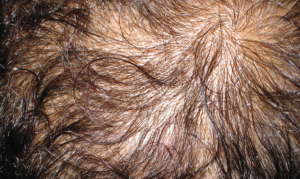Chapter 14: Hair and Nails
Diffuse Non-Scarring Alopecia
Telogen Effluvium: Telogen effluvium occurs when a significant portion of the hair simultaneously enters resting phase (telogen) due to an acute stress, illness, or rapid dietary change such as crash diet. Several months later, this hair is shed and thinning is noticed. After a few months, the hair will begin to regrow normally and no treatment is needed.
Anagen Effluvium: Cytotoxic chemotherapy medications cause arrest in hair growth and subsequent hair loss. Hair is shed during the growth (anagen) phase and will regrow after completion of chemotherapy.
Androgenetic alopecia: Patterned hair loss occurs in both men and women but is generally more pronounced in males. It can begin in adolescence, though usually does not appear until adulthood. Thinning occurs over the crown as well as frontal scalp. In men, it often presents with receding frontal hair line and vertex of the scalp and can progress to complete hair loss. In women, widening of central part is more common. Treatment is with minoxidil topically or finasteride depending on clinical context and severity.
Loose anagen syndrome: An uncommon form of hair loss noted in young children. It most typically presents in young girls who present with the history of never needing a haircut. In this condition, the hairs are not well attached to the scalp during growth phase and so fall out before they reach full length. It tends to improve with age.


